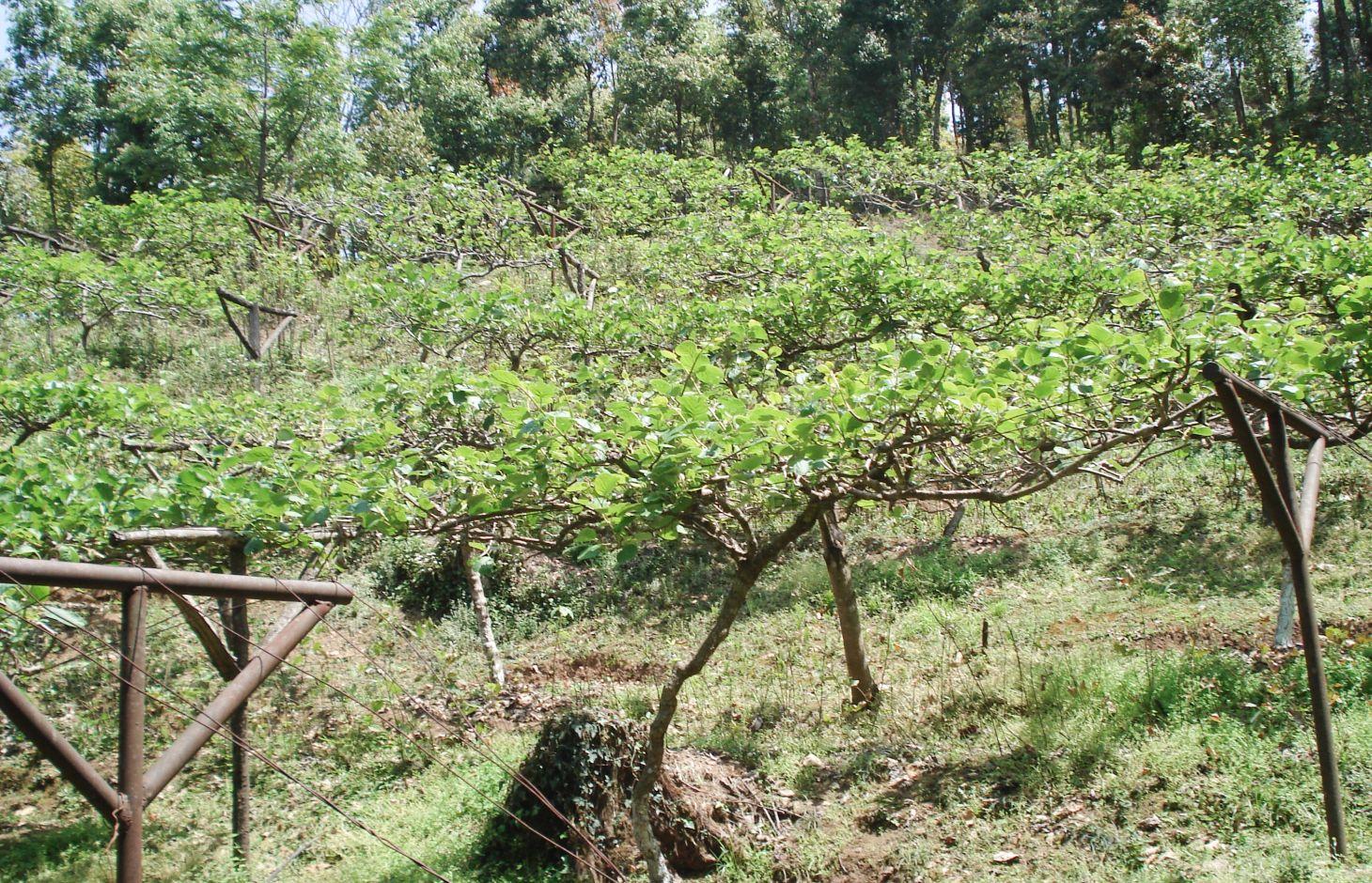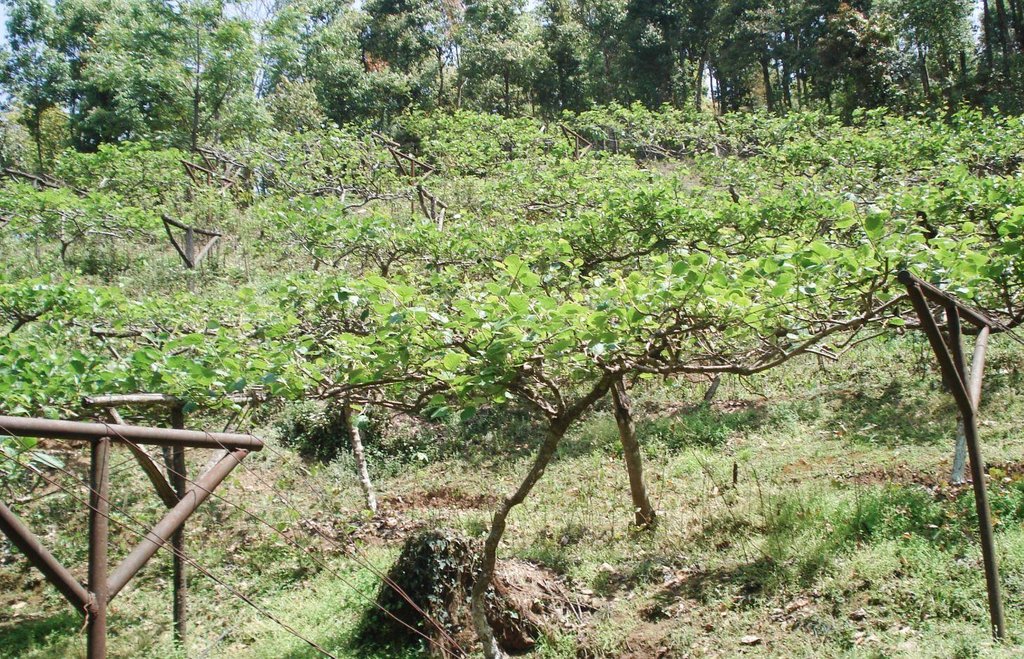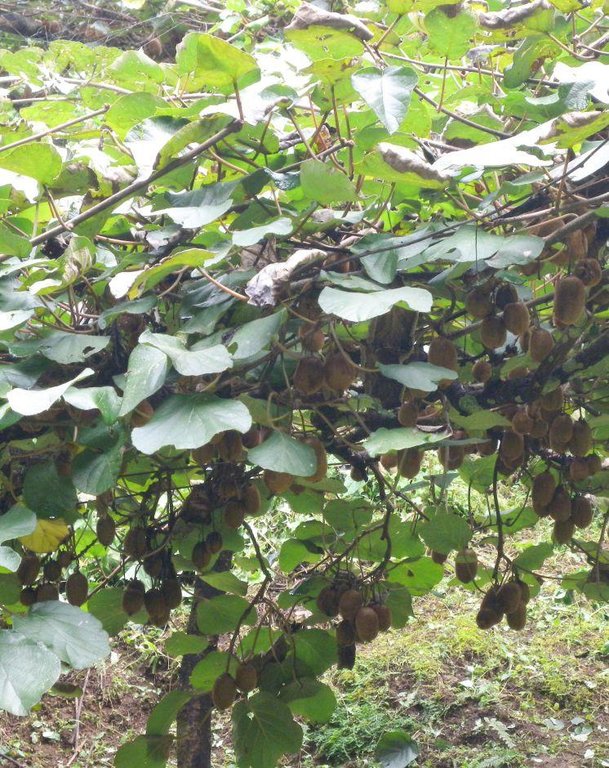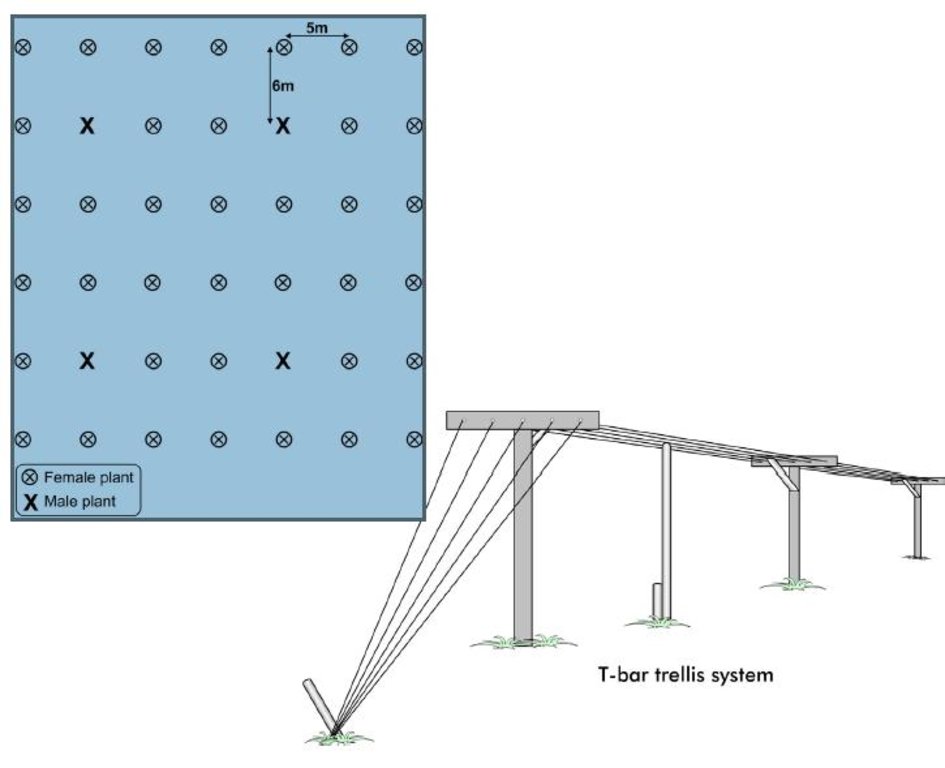Kiwi fruit cultivation [Nepal]
- Creation:
- Update:
- Compiler: Shreedip Sigdel
- Editor: –
- Reviewers: David Streiff, Alexandra Gavilano
kiwi (theki) fal kheti (Main Contributor: Samden Sherpa, ICIMOD)
technologies_1686 - Nepal
View sections
Expand all Collapse all1. General information
1.2 Contact details of resource persons and institutions involved in the assessment and documentation of the Technology
SLM specialist:
Sherpa Samden Lama
ICIMOD
Nepal
Name of the institution(s) which facilitated the documentation/ evaluation of the Technology (if relevant)
ICIMOD International Centre for Integrated Mountain Development (ICIMOD) - Nepal1.3 Conditions regarding the use of data documented through WOCAT
The compiler and key resource person(s) accept the conditions regarding the use of data documented through WOCAT:
Yes
2. Description of the SLM Technology
2.1 Short description of the Technology
Definition of the Technology:
Kiwi fruit cultivation on sloping land in the mid-hill areas of Nepal can help prevent soil erosion and is a sustainable land management practice. This high value crop introduces biodiversity and improves livelihoods by providing a source of cash income.
2.2 Detailed description of the Technology
Description:
The kiwi fruit is native to China. Previously called Chinese gooseberry, it is now more commonly known by its marketing name of kiwi fruit. Kiwi fruits grow on large vines that are similar to grapevines in their general growth and fruiting habits as well as their training and trellising requirements. The fruit normally ripens within 25 weeks after the flowers first appear. The fruits range in weight from 40 to 90 g and can be picked shortly after the first frost in autumn; after that, they can be kept in cold storage for 4–6 months at oC. Kiwi vines can be grown on a wide range of soil types at elevations ranging from 1000 m to 2500 m. The kiwi plant is dioecious, meaning individual plants are either male or female. Only female plants bear fruit, but only when pollinated by a male plant. Vines of both sexes are essential for fruit production, and they must flower at the same time to ensure pollination. One male pollinator vine is required for eight female vines. The vines are commonly supported on sturdy structures strong enough to bear the heavy fruit, which might otherwise break the rather weak vines. T-bars or hitching post trellises are recommended to support the large fruiting area in the form of a canopy and provide easy access to the fruit.
Establishment / maintenance activities and inputs: Seedlings can be planted in the spring as soon as there is little chance of frost. Vines need to be pruned both in summer and in winter to maintain a balance between kiwi plant growth and profitable fruit production. Excessive plant growth is removed during the growing season to keep the kiwi canopy open and to remove non-fruiting wood. Harvesting can begin from the end of November. Frequent weeding is required to reduce competition for moisture and fertilizer. Kiwi fruit requires abundant water; during the dry season the newly planted kiwi vines need deep watering once a week.
2.3 Photos of the Technology
2.5 Country/ region/ locations where the Technology has been applied and which are covered by this assessment
Country:
Nepal
Further specification of location:
Lalitpur District
Specify the spread of the Technology:
- evenly spread over an area
If the Technology is evenly spread over an area, specify area covered (in km2):
0.01
Comments:
Total area covered by the SLM Technology is 0.01 km2.
2.7 Introduction of the Technology
Specify how the Technology was introduced:
- during experiments/ research
3. Classification of the SLM Technology
3.1 Main purpose(s) of the Technology
- reduce, prevent, restore land degradation
- create beneficial economic impact
3.2 Current land use type(s) where the Technology is applied

Cropland
- Perennial (non-woody) cropping
- Tree and shrub cropping
Perennial (non-woody) cropping - Specify crops:
- berries
- kiwi
Number of growing seasons per year:
- 2
Comments:
Major land use problems (compiler’s opinion): When sloping land is not used for agricultural production and not planted with ground cover or other vegetation (such as contour hedgerows), the fertile soil can be eroded and washed away by heavy monsoon rains.
3.5 SLM group to which the Technology belongs
- improved plant varieties/ animal breeds
3.6 SLM measures comprising the Technology

vegetative measures
- V1: Tree and shrub cover
3.7 Main types of land degradation addressed by the Technology

soil erosion by water
- Wt: loss of topsoil/ surface erosion

chemical soil deterioration
- Cn: fertility decline and reduced organic matter content (not caused by erosion)
Comments:
Main causes of degradation: deforestation / removal of natural vegetation (incl. forest fires)
3.8 Prevention, reduction, or restoration of land degradation
Specify the goal of the Technology with regard to land degradation:
- reduce land degradation
4. Technical specifications, implementation activities, inputs, and costs
4.1 Technical drawing of the Technology
Technical specifications (related to technical drawing):
Above: Layout of a kiwi orchard. The ideal density of kiwi plants in an orchard is 300 per ha, or in terms of the units of measure commonly used in Nepal, 15 plants per ropani. The plants are spaced 6 m apart and the distance between the rows is 5 m, with a male to female plant ratio of 1:8.
Below: T-bars are used as trellis supports for the kiwi vines. The T-bars are 2.5–3 m long iron posts that are anchored into the ground; they extend approximately 1.8 m above the ground and 60–70 cm deep into the soil. The arms of the T-bar extend 1–1.2 m. The bars are spaced approximately 4.5 m apart with galvanized wire strung between them and pulled taught to form the trellis itself. The end posts are braced by 4–5 wires that are secured into the ground (as shown).
The kiwi plants should be at least
0.6 m away from the T-bars. The centre wire supports the main cordons, and the outer wires support the fruiting lateral parts.
Technical knowledge required for field staff / advisors: moderate
Technical knowledge required for land users: moderate
Main technical functions: improvement of ground cover, increase of biomass (quantity), Reduce soil erosion
Secondary technical functions: control of concentrated runoff: impede / retard, reduction of slope angle
Author:
AK Thaku
4.2 General information regarding the calculation of inputs and costs
Specify how costs and inputs were calculated:
- per Technology area
Indicate size and area unit:
ha
Specify currency used for cost calculations:
- USD
Indicate average wage cost of hired labour per day:
3.7
4.3 Establishment activities
| Activity | Timing (season) | |
|---|---|---|
| 1. | • The plot where the vines are to be planted is prepared by clearing and weeding.• The seedling pits are prepared at least 2 months before planting. Typically the pits are 1 m x 1 m and 1 m deep. The pits are filled with compost (30 kg per pit ) and covered with soil to a height of 0.3 m above the ground. | 2 months |
| 2. | • Seedlings are planted in the winter to the same depth as in the nursery; they are planted 6 m apart in rows spaced 5 m apart.• The plants are pruned back to single, healthy shoots 15–30 cm high. |
4.4 Costs and inputs needed for establishment
| Specify input | Unit | Quantity | Costs per Unit | Total costs per input | % of costs borne by land users | |
|---|---|---|---|---|---|---|
| Labour | Prepare pits and seedlings | persons/day/ha | 136.0 | 3.6765 | 500.0 | |
| Plant material | Planting material | ha | 1.0 | 1500.0 | 1500.0 | |
| Fertilizers and biocides | Compost / manure | ha | 1.0 | 150.0 | 150.0 | |
| Construction material | Iron pole | ha | 1.0 | 3500.0 | 3500.0 | |
| Total costs for establishment of the Technology | 5650.0 | |||||
| Total costs for establishment of the Technology in USD | 5650.0 | |||||
4.5 Maintenance/ recurrent activities
| Activity | Timing/ frequency | |
|---|---|---|
| 1. | Permanent sod is maintained between the plant rows. Frequent weeding is required especially during the rainy season.• Both summer and winter pruning is required. | |
| 2. | • Cuttings from branches that fruited during the previous season (typically less than a pencil width in thickness) are collected during the winter pruning for propagation.• Overhead sprinkler irrigation is used for commercial kiwi production.• Kiwi vines are fertilized with manure in the early spring |
4.6 Costs and inputs needed for maintenance/ recurrent activities (per year)
| Specify input | Unit | Quantity | Costs per Unit | Total costs per input | % of costs borne by land users | |
|---|---|---|---|---|---|---|
| Labour | Maintenance and prunning | persons/day/ha | 122.0 | 3.6885 | 450.0 | |
| Equipment | Secateurs | ha | 1.0 | 50.0 | 50.0 | |
| Equipment | Binding wire | ha | 1.0 | 650.0 | 650.0 | |
| Fertilizers and biocides | Compost / manure | ha | 1.0 | 150.0 | 150.0 | |
| Total costs for maintenance of the Technology | 1300.0 | |||||
| Total costs for maintenance of the Technology in USD | 1300.0 | |||||
4.7 Most important factors affecting the costs
Describe the most determinate factors affecting the costs:
The above establishment cost is for a plantation of 300 plants on one hectare; the recurrent annual maintenance cost has been calculated for a plantation of 300 plants per ha per year. All costs are estimated based on experience gained at the ICIMOD Knowledge Park at Godavari.
5. Natural and human environment
5.1 Climate
Annual rainfall
- < 250 mm
- 251-500 mm
- 501-750 mm
- 751-1,000 mm
- 1,001-1,500 mm
- 1,501-2,000 mm
- 2,001-3,000 mm
- 3,001-4,000 mm
- > 4,000 mm
Agro-climatic zone
- sub-humid
Thermal climate class: subtropics
5.2 Topography
Slopes on average:
- flat (0-2%)
- gentle (3-5%)
- moderate (6-10%)
- rolling (11-15%)
- hilly (16-30%)
- steep (31-60%)
- very steep (>60%)
Landforms:
- plateau/plains
- ridges
- mountain slopes
- hill slopes
- footslopes
- valley floors
Altitudinal zone:
- 0-100 m a.s.l.
- 101-500 m a.s.l.
- 501-1,000 m a.s.l.
- 1,001-1,500 m a.s.l.
- 1,501-2,000 m a.s.l.
- 2,001-2,500 m a.s.l.
- 2,501-3,000 m a.s.l.
- 3,001-4,000 m a.s.l.
- > 4,000 m a.s.l.
5.3 Soils
Soil depth on average:
- very shallow (0-20 cm)
- shallow (21-50 cm)
- moderately deep (51-80 cm)
- deep (81-120 cm)
- very deep (> 120 cm)
Soil texture (topsoil):
- medium (loamy, silty)
Topsoil organic matter:
- high (>3%)
If available, attach full soil description or specify the available information, e.g. soil type, soil PH/ acidity, Cation Exchange Capacity, nitrogen, salinity etc.
Soil fertility is medium
Soil drainage / infiltration is medium
Soil water storage capacity is medium
5.4 Water availability and quality
Ground water table:
< 5 m
Availability of surface water:
good
Water quality (untreated):
good drinking water
Comments and further specifications on water quality and quantity:
Water quality (untreated): Also for agricultural use (irrigation)
5.5 Biodiversity
Species diversity:
- high
Comments and further specifications on biodiversity:
695 species of flora and 230 species of fauna have been documented within the Knowledge Park's 30 ha area
5.6 Characteristics of land users applying the Technology
Market orientation of production system:
- mixed (subsistence/ commercial)
Off-farm income:
- > 50% of all income
Level of mechanization:
- manual work
- animal traction
Indicate other relevant characteristics of the land users:
Population density: < 10 persons/km2
5.7 Average area of land used by land users applying the Technology
- < 0.5 ha
- 0.5-1 ha
- 1-2 ha
- 2-5 ha
- 5-15 ha
- 15-50 ha
- 50-100 ha
- 100-500 ha
- 500-1,000 ha
- 1,000-10,000 ha
- > 10,000 ha
5.8 Land ownership, land use rights, and water use rights
Land ownership:
- state
Land use rights:
- communal (organized)
- individual
Water use rights:
- communal (organized)
- individual
5.9 Access to services and infrastructure
roads and transport:
- poor
- moderate
- good
Labour:
- poor
- moderate
- good
6. Impacts and concluding statements
6.1 On-site impacts the Technology has shown
Socio-economic impacts
Water availability and quality
demand for irrigation water
Socio-cultural impacts
food security/ self-sufficiency
Comments/ specify:
Kiwi is considered an elite fruit and it is usually too expensive for local consumption
community institutions
SLM/ land degradation knowledge
livelihood and human well-being
Comments/ specify:
Kiwi production can be a good source of cash income as it is a high value crop. Kiwi fruit is high in nutrients, eating kiwis has been show to boost the immune system, to help regulate blood pressure, and to be beneficial for cardiac patients
Ecological impacts
Soil
soil cover
soil loss
Biodiversity: vegetation, animals
biomass/ above ground C
Other ecological impacts
Pollen for bees
biodiversity
efficient use of land
competition with other plants for water, nutrients, and sunlight when intercropping
6.2 Off-site impacts the Technology has shown
downstream flooding
buffering/ filtering capacity
6.3 Exposure and sensitivity of the Technology to gradual climate change and climate-related extremes/ disasters (as perceived by land users)
Climate-related extremes (disasters)
Meteorological disasters
| How does the Technology cope with it? | |
|---|---|
| local rainstorm | well |
| local windstorm | not well |
Climatological disasters
| How does the Technology cope with it? | |
|---|---|
| drought | not well |
Other climate-related consequences
Other climate-related consequences
| How does the Technology cope with it? | |
|---|---|
| Mild winter frost | well |
Comments:
A net canopy can be used to protect the vines from hail storms and help prevent fruit from dropping prematurely
6.4 Cost-benefit analysis
How do the benefits compare with the establishment costs (from land users’ perspective)?
Short-term returns:
positive
Long-term returns:
very positive
How do the benefits compare with the maintenance/ recurrent costs (from land users' perspective)?
Short-term returns:
slightly positive
Long-term returns:
very positive
Comments:
The approximate annual income from kiwi production is USD 11,765/ha/year. The technology provides on-farm employment opportunities for both men and women.
6.5 Adoption of the Technology
- single cases/ experimental
Comments:
There is a moderate trend towards spontaneous adoption of the Technology
Comments on adoption trend: Kiwi fruit is gaining in popularity in Nepal; at present it is cultivated commercially by farmers in Kavre, Lalitpur, Dolakha, and Ilam Districts as well as in the Kathmandu Valley. The technology is widely accepted. Kiwi saplings were initially supplied by ICIMOD and by a private nursery in Kavre District.
Driver for adoption:
• Increased market demand for kiwi fruit
• A good alternative for sloping land management
• Kiwi cultivation is a source of income generation
Constraints
• It has been difficult to meet the high demand for kiwi seedlings. The scarcity of seedlings is the main bottleneck limiting the uptake of kiwi production.
6.7 Strengths/ advantages/ opportunities of the Technology
| Strengths/ advantages/ opportunities in the compiler’s or other key resource person’s view |
|---|
|
Orchards are easy to establish and farmers can readily learn what is needed for kiwi cultivation How can they be sustained / enhanced? Awareness and training programmes can help farmers quickly learn what is needed for kiwi cultivation. |
|
The benefits of the technology are easy to observe; farmers generate cash income from selling kiwi fruit, juice, and jam. How can they be sustained / enhanced? Awareness and training programmes can help farmers quickly learn what is needed for kiwi cultivation and postharvest processing. |
|
Soil erosion is decreased due to increased groundcover. How can they be sustained / enhanced? Awareness and training programmes can help farmers quickly learn what is needed for kiwi cultivation. |
|
Kiwi cultivation provides on-farm employment opportunities. How can they be sustained / enhanced? Awareness and training programmes can help farmers quickly learn what is needed for kiwi cultivation. |
6.8 Weaknesses/ disadvantages/ risks of the Technology and ways of overcoming them
| Weaknesses/ disadvantages/ risks in the compiler’s or other key resource person’s view | How can they be overcome? |
|---|---|
| The initial costs associated with establishing the orchard may be a little expensive for many farmers, these include the purchase of: T-bar trellises, seedlings, iron rods, and wire. | Begin by using locally available materials such as bamboo poles to make T-bar trellis. |
7. References and links
7.1 Methods/ sources of information
7.3 Links to relevant online information
Title/ description:
Kiwi fruit production guide. Tuscaloosa, Alabama, United States: Alabama University, Himelrick, DG; Powell, A (1998)
URL:
http://www.aces.edu/pubs/docs/A/ANR-1084/ANR-1084.pdf
Links and modules
Expand all Collapse allLinks
No links
Modules
No modules





